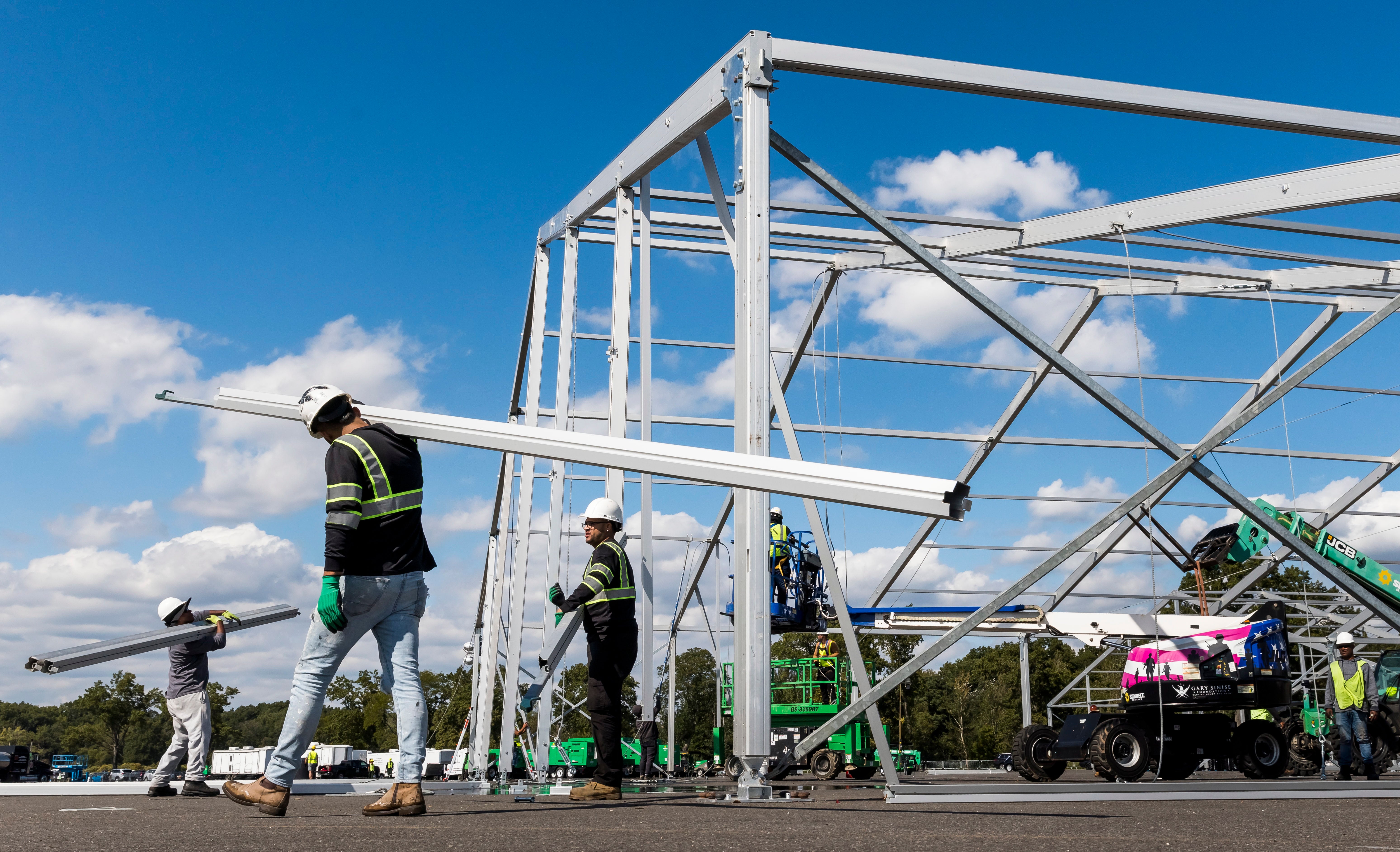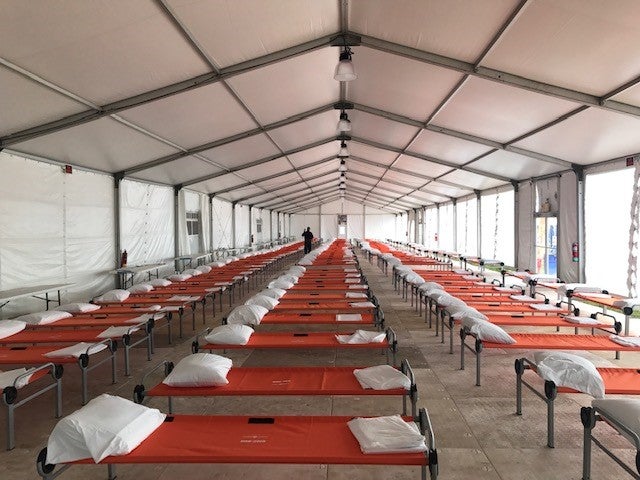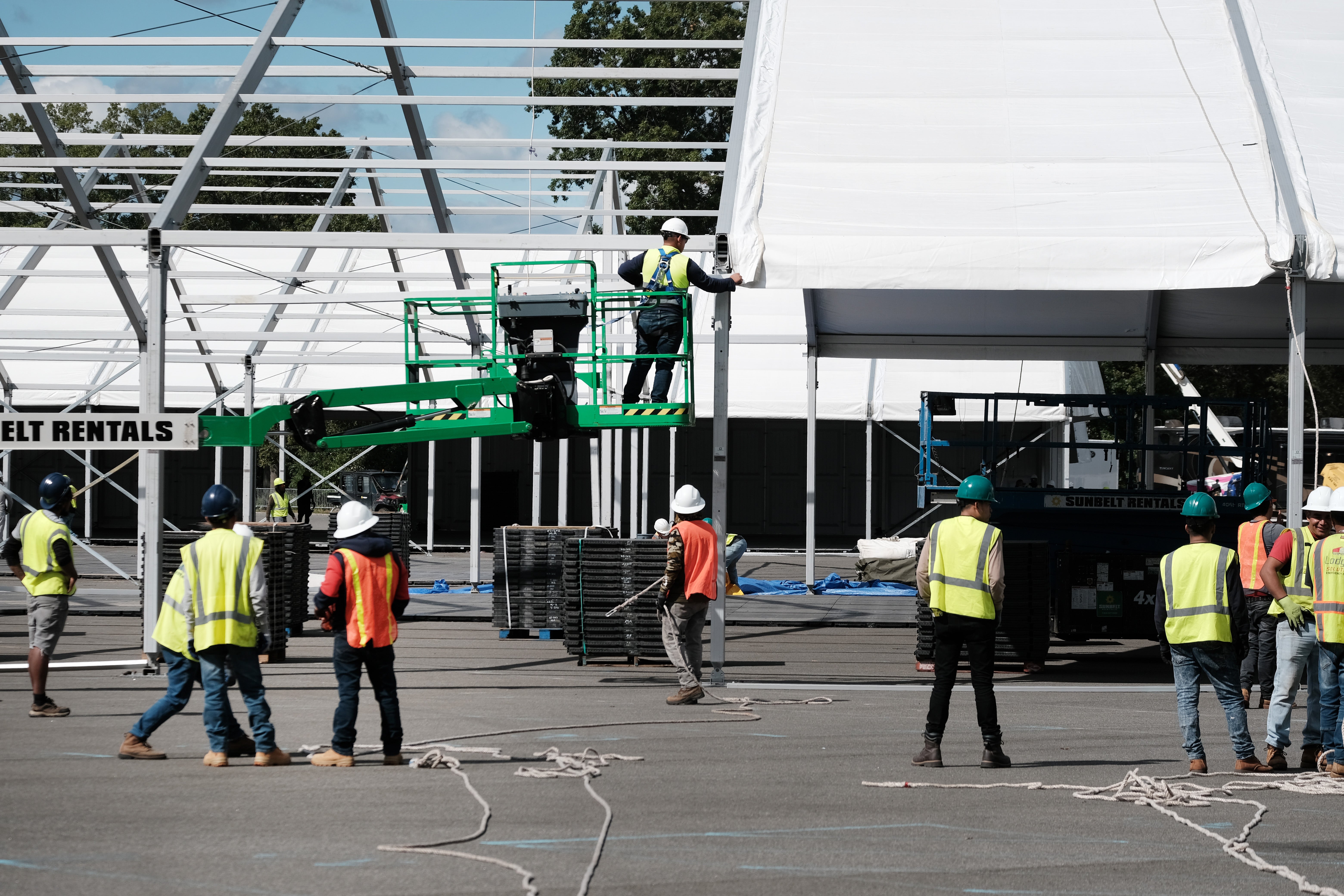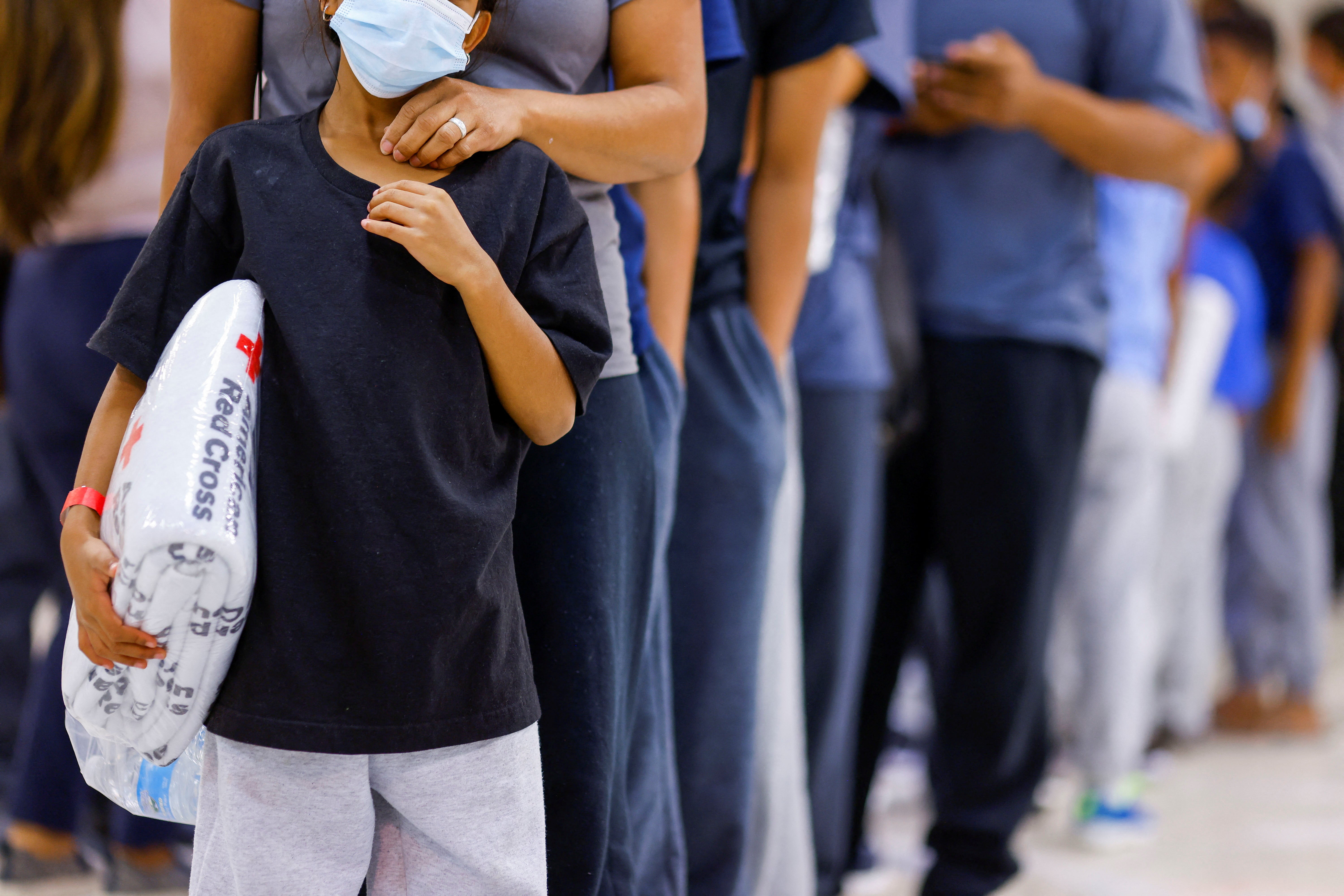Why Eric Adams is building a migrant ‘tent city’ in The Bronx
Thousands of people seeking asylum have recently arrived in New York City, where an overburdened shelter system is strained by compounding crises. The mayor’s latest plan worries advocates who fear it could violate right-to-shelter mandate, Alex Woodward reports


Your support helps us to tell the story
From reproductive rights to climate change to Big Tech, The Independent is on the ground when the story is developing. Whether it's investigating the financials of Elon Musk's pro-Trump PAC or producing our latest documentary, 'The A Word', which shines a light on the American women fighting for reproductive rights, we know how important it is to parse out the facts from the messaging.
At such a critical moment in US history, we need reporters on the ground. Your donation allows us to keep sending journalists to speak to both sides of the story.
The Independent is trusted by Americans across the entire political spectrum. And unlike many other quality news outlets, we choose not to lock Americans out of our reporting and analysis with paywalls. We believe quality journalism should be available to everyone, paid for by those who can afford it.
Your support makes all the difference.Crews in fluorescent vests and hard hats were pictured erecting tall metal frames in a massive parking lot in The Bronx this week, beginning construction of an ambitious shelter facility to temporarily house 1,000 people, including hundreds of migrants bused from Texas to New York City by the state’s Republican governor.
“Humanitarian Emergency Response and Relief Centers” will include rows of individual cots inside five climate-controlled, airplane hangar-sized tents, intended as a “first touch point” for asylum seekers arriving in New York, with “immediate” access to medical care, case work services and other support, according to the city.
Thousands of migrants have arrived in New York within the last several months, with hundreds of people arriving on buses chartered by Texas Governor Greg Abbott, whose widely derided efforts have spent millions of dollars to remove people seeking asylum from the state to Democrat-led cities hundreds of miles away.
The city has raced to open additional shelter spaces but has been swiftly outpaced by a growing need. The population of people living in shelters has grown by roughly 25 per cent within the last few months to nearly 60,000 people, driven partially by the arrival of migrants.
But the lack of adequate shelter space is compounded by an already-strained shelter system.
New York is the only city in the country that is legally bound to a “right to shelter” for anyone who needs it, though Mayor Eric Adams has said the city’s “prior practices … must be reassessed” as the shelter system reaches a “breaking point”.
Former Mayor Bill de Blasio’s administration eliminated substandard properties from the city’s shelter system with the aim of opening more centrally located shelter sites with better access to a range of supportive services.
A plan under his administration would open 90 shelter facilities by the end of 2023. But most of those shelters have not yet opened, and residents have rallied in some neighbourhoods to block their construction.
Waiting lists for permanent housing and government-supported housing voucher programmes often are months or years long. And the expiration of an eviction moratorium after two years of housing protections during the Covid-19 pandemic has housing advocacy groups concerned of a looming eviction crisis.
Construction on the project near Orchard Beach began on 26 September and is expected to finish within the coming weeks.
Legal aid and homeless advocacy groups have warned that the tent shelters could violate the city’s right to shelter mandate, a more than 40-year-old policy that has established minimum standards for what a shelter must provide.
“New York City’s right to shelter is explicit: Anyone in need of a bed, including asylum seekers, is entitled to one, and this administration has pledged to fully comply with these well-established court orders which ensure this fundamental right,” according to a joint statement from New York’s Legal Aid Society and Coalition for the Homeless on 27 September.
Under the mandate, people seeking shelter request housing at Department of Homeless Services intake centres, after which the city must promptly provide that shelter.
But the temporary tents in The Bronx parking lot instead will be operated by the New York City Emergency Management and the Health + Hospitals Corp. The administration wants to route migrants directly to the tents rather than the overburdened shelter system.
Models of the site showing rows of densely packed cots are “devastating,” according to Kathleen Cash with the Urban Justice Center’s Safety Net Project.
“Opening short-term municipal refugee camps through a separate city bureaucracy – while the city repeatedly failed to honor the right to shelter, and has announced plans to ‘reassess’ it – is the kind of approach many feared this administration would take,” she said in a statement.

The groups similarly criticised Mayor Adams’s suggestion that migrants could be temporarily housed on cruise ships, which are “not designed to provide shelter and services to homeless people, especially those with disabilities, and they will likely be docked in locations that would impede critical access to jobs, health care, schools, child care, community-based services, and much more,” according to the Legal Aid Society and Coalition for the Homeless.
Mayor Adams’s administration “must focus on transitioning New Yorkers, especially those who have languished at local shelters for long periods of time, out of shelters and into permanent housing,” according to the groups. “Helping people move to permanent housing more quickly would bolster shelter capacity across the board so the City can accommodate new entrants to the system.”
The mayor has defended the plan, arguing that the city’s shelter obligations and growing pressure to provide humanitarian relief are different crises.
“No one thought that we would be receiving over 13,000 people for housing,” he said during a press conference on 27 September. “We are going to treat everyone in a humane fashion, but these are two different entities.”
He compared the current crisis to the onset of the Covid-19 pandemic in 2020, when the city adapted a convention hall, race track, cruise terminal and college campus to care for sick patients.
“To those who are saying it’s inhumane to use tents, I’m like, what are people talking about?” he added “There was a tent in Central Park during Covid. Did people forget I was on the ground in Covid?”
Earlier this month, a woman seeking asylum in the US who has lived in a New York shelter for four months died by suicide.
“The failure was the governors that sent people on a multi-day bus ride without proper food, without medical care, without basic necessities, telling them they had to be treated in this inhumane way,” Mayor Adams said in an unrelated press conference on 19 September. “We didn’t fail in this city. This city is helping people. And again, my heart goes out to that family.”

New York’s statewide right to shelter is a relatively straight-forward mandate – not a law, but a right repeatedly affirmed by court orders with oversight protections.
Following a class action lawsuit filed in 1979 on behalf of homeless New Yorker Robert Callahan, the state Supreme Court in Callahan v Carey ordered the city and state to provide shelter for homeless men as a right supported by the state constitution.
Following two years of negotiations in the wake of the ruling, the case was settled as a consent decree with the city and state, mandating shelter for those who need it, and outlining minimum standards for care in the shelter systems. Coalition for the Homeless also was appointed to monitor the conditions and progress of the mandate.
Callahan died while sleeping on the streets before the consent decree was signed, one of the last homeless New Yorkers who died in an era without a legal right to shelter.
In the decades that followed, legal challenges against the city alleged numerous violations of the mandate, prompting a series of court rulings to expand shelter protections for women and families and force the state to open more beds.

More than 52,000 people are living in New York City shelters on a given night, according to Coalition for the Homeless, while thousands of others live in other shelters, on the streets and in subway stations and trains.
The organisation’s 2022 report examining the state of homelessness in the city underscored officials “continued failure to address the underlying causes” of the crisis, including a lack of investment in affordable housing that has left thousands of households with annual incomes below $30,000 at risk of homelessness while paying more than half of their incomes on rent.
A separate report found that the number of apartments renting for less than $1,500 per month fell from 1.6 million in the early 1990s to fewer than 1 million by 2021, while apartments that rent for $2,300 a month or more grew from fewer than 90,000 apartments to more than 500,000 within that same time.
Roughly 53 per cent of the city’s renters pay more than 30 per cent of their incomes on housing costs, while 32 per cent of renters pay more than half.
The coalition has called on the mayor’s office and Governor Kathy Hochul to “cease treating unsheltered homeless individuals as a public nuisance requiring an aggressive law enforcement response – an approach not only inhumane, but ineffective – and instead embrace the solutions proven to work, including permanent supportive housing, more mental health resources, and safer, low-barrier shelters.”

Since April, Governor Abbott has bused people seeking asylum in the US to Democratic cities on the East Coast to provide what he has called “much-needed relief” to border communities and to protest what Republican governors have characterised as President Joe Biden’s “open border” agenda.
Thousands of migrants have been sent to New York, Chicago and Washington DC.
Millions of people have fled Venezuela in the wake of the country’s political and economic collapse, driving dangerous, often months-long northern journeys through Central America and Mexico where migrants risk cartel violence, trafficking and abuse.
“Failing” regimes in Venezuela as well as Cuba and Nicaragua “are driving a new wave of migration across the Western Hemisphere, including the recent increase in encounters at the southwest US border,” according to a statement from US Customs and Border Protection Commissioner Chris Magnus.
The number of Venezuelans seeking entry into the US has steadily climbed in recent years. In July, US Customs and Border Protection officials reported encounters with Venezeulan migrants reached more than 17,000, triple the number that was reported one month earlier.
Asylum claims can only be made while in the US. After surrendering to authorities, migrants seeking asylum for humanitarian assistance or protection must first pass what is called a “credible threat” screening, after which they will receive a notice to appear before an immigration judge for consideration of those claims.
Governor Abbott’s two-day bus trips from Texas to New York began as the city phased out the use of hotels for families with children and substandard properties from its shelter portfolio.
The growing need for shelter to house incoming migrants and people experiencing homeless also has fallen against a winnowing city budget. The Adams administration has tasked city agencies with cutting their budgets by 3 per cent this year.
In an interview with Rev Al Sharpton on MSNBC on 24 September, the mayor condemned Governor Abbott’s “inhumane, uncooperative” scheme.
“We will always fulfill our moral and legal obligation to house New Yorkers and those who come to this city. This is not a homeless issue – this is a migrant, refugee, asylum crisis that we are facing and this is a humanitarian action that was created by human hands,” he added.
Critics of the plan “need to look at it through the proper prism,” he said, “and not try to state that we’re not meeting our obligations both legally and morally.”



Join our commenting forum
Join thought-provoking conversations, follow other Independent readers and see their replies
Comments